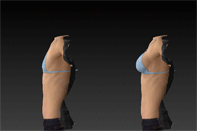When it comes to changing the look, shape, or size of their breasts, some women can get a little confused as to what kind of procedure they should get.
Breast lift or breast augmentation – or a combination thereof?
Plastic surgeons often hear the question: “what’s the difference between a breast lift and breast augmentation?”
We’re going to look at both procedures, what they entail, possible outcomes, and general cost so that you can get a better idea of what to ask for when you sit down for a consultation.
Breast Augmentation
The purpose of a breast augmentation procedure is to enhance the size of the breasts. Augmentation involves breast implants and several important decisions on both the part of the surgeon and the patient. Some of the things that will need to be decided before undergoing the knife are:
Implant Placement and Incision – The exact spot where the surgeon places the breast implant will play a role in determining the shape of the breast. During the initial consultation, the surgeon will explain the various outcomes that will result from placement in different areas.
The patient and surgeon will also need to agree on where the incision should take place. The most common areas for incision are under the armpit, under the fold of the breast, or around the nipple. Each incision area has advantages and disadvantages that the surgeon will also explain during the consultation.
Implant Shape and Size – There are many options available for changing the shape and size of the breasts. Some of these options will need to be weighed against the body features of the prospective patient.
The chest wall shape, body form, lifestyle, and overall goals will all need to be taken into consideration with regards to choosing the final shape and size of the breasts. A good surgeon will have recommendations and can help guide the patient into making a decision in which she will be pleased with the outcome.
Type of Implant – Patients will also need to figure out if they want saline or silicone implants. Silicone is usually more expensive, requires a much larger incision, and can involve more work for the surgeon.
The trade off is that silicone implants have a more natural look and feel to them which is excellent for women who have little natural breast tissue.
Saline implants can add shape and volume without changing the overall feel of the breasts. They tend to work best for women who have ample natural breast tissue.
Breast Lift
When breasts lose volume, they tend to sag. This happens most often as women get older and their bodies start to change. Childbirth and weight loss or gain can also cause breasts to sag. Breast lifts completely avoid implants and instead focus on the surgical correction and lifting of saggy breasts.
There are three main types of breast lift procedures:
Periareolar – The incision approach from this procedure follows the natural areola shape and works best for women who have large areolas with minimal breast sagging.
Vertical breast reduction – This procedure is similar to the periareolar one, but it also extends downwards from the areola, thereby giving a slightly greater lift for women who have moderate sagging issues.
Inverted-T incisions – This is the most common procedure and produces relatively predictable results. It gives the maximum amount of breast lift possible.
Can You Combine Both?
At the end of the day, the work that will be done will be contingent upon the desires of the patient and the expertise of the surgeon. Sometimes this means that a surgeon might recommend both a breast augmentation and breast lift. This is done to help restore the breasts to what they looked like when the patient was younger.
Which One is Right for You?
Changing the shape and size of your breasts is a very personal decision that shouldn’t be taken lightly or based solely on a picture you saw in a magazine or on the internet.
This is why it’s so important that you choose a qualified plastic surgeon who has the experience and know-how to help guide your decision and give you the results that you’re looking for.
Dr. Adams is not only an accomplished plastic surgeon and Associate Clinical Professor of Plastic Surgery at UT Southwestern Medical Center, but he’s also an international authority on breast augmentation and enlargement. Women from all over the country fly into Dallas to have Dr. Adams perform their breast lifts and augmentations.
Breast Lifts and Augmentations in Dallas
If you’re unhappy with the shape, size, or sagginess of your breasts, give the offices of Dr. Adams a call at (214) 965-9885 or contact us via our website. We’re conveniently located just a short ride from DFW airport. Dr. Adams and his staff will help you regain lost confidence and a new outlook on life!















